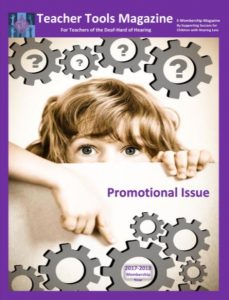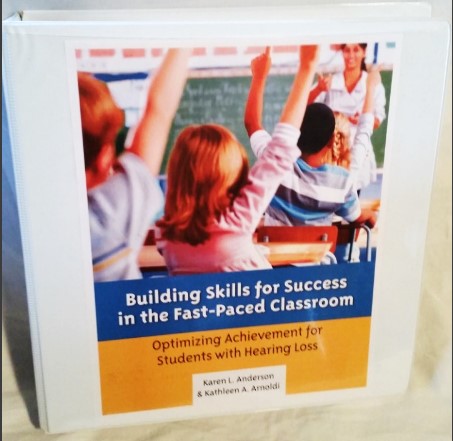Improving the Outcomes of Children with Hearing Loss
Our mission is to help YOU to improve the futures of children who are hard of hearing or deaf.
| How we help improve children’s futures: 1) Accessible Information & Resources 2) Relevant Bi-Monthly Newsletters (FREE) 3) Professional Development Webcasts 4) Products to improve student outcomes 5) Teacher Tools Member Magazine teacher materials/strategies 6) Biennial SSCHL Conference next: February 14-16, 2019, Texas 7) Advocacy Information for Appropriate Services 8) Publisher of great products to improve outcomes! |
Supporting Success is a ‘go-to’ site for professionals and family members seeking more information about hearing loss and what can be done to better support the future learning and social success of children with hearing loss*.
Only 1 in 100 students with IEPs receive services primarily due to hearing loss. Hearing loss causes educational performance issues due to access barriers, not learning disorders. |
Get ready for a new SSCHL! The new website will be online by August. Mobile-friendly, easy to navigate!
 See our FREE Promotional Issue for the 2017-2018 Teacher Tools membership year. Enjoy the flippable e-Magazine format and great information!
See our FREE Promotional Issue for the 2017-2018 Teacher Tools membership year. Enjoy the flippable e-Magazine format and great information!
Join us on Facebook!
Professional Resource Topics Downloadable Summary of Site Content
| Amplification | Assessment | Early Childhood | Sign up for Free Bi-Monthly Updates Now 11,500 subscribers! |
| Hearing Loss | Language | Legal Issues | |
| Listening | Planning to Meet Needs | Self-Advocacy | CATALOG On Sale? |
| Self-Concept | Social Issues | Speech Perception | SEE video about Interact-AS Speech-to-Text Captioning |
Join more than 1250 2016-2017 members. May Review Teacher Tools materials now posted! |
|||
| Upcoming Bimonthly Update topics vary each issue. See newsletters since August here. Sign up to receive these free Updates! | |||
 We listened!
We listened!
Building Skills for Success in the Fast-Paced Classroom is our best seller, owned by about 1/4 of the DHH teachers in the US. As many of you know, with frequent use the book’s binding can wear out in about 6 months. We are now selling Building Skills for Success in a 3-ring binder format only. You can easily add your own resources to the binder or combine the Steps to Success materials and https://sites.ed.gov/idea/regs/b/b/300.113 or Advocacy in Action print outs with Building Skills for Success to create your own awesome ‘grab and go’ teaching library!
 Access truly is the name of the game! Yet how do we know how WELL our students are truly accessing information presented in the classroom. Let’s work together to figure out practical ways to assess the level of access. See our working draft of Estimating-Access-of-Communication-Effectiveness. There is still much to be figured out! What do YOU do? We would love to collaborate with some interested DHH teams on this project. Contact Karen for comments. Now working on Draft 4! Still time to add your comments and expertise to the process!
Access truly is the name of the game! Yet how do we know how WELL our students are truly accessing information presented in the classroom. Let’s work together to figure out practical ways to assess the level of access. See our working draft of Estimating-Access-of-Communication-Effectiveness. There is still much to be figured out! What do YOU do? We would love to collaborate with some interested DHH teams on this project. Contact Karen for comments. Now working on Draft 4! Still time to add your comments and expertise to the process!
Check out our Trio Combos! Professional Development NOW!
Supporting Success for Children with Hearing Loss is now offering 13 webcasts with 3 brand new offerings! Each is typically one hour and you have 300 days to view. Go to webcasts for more info. Our Webcast Trio Combos allow you to purchase 3 one-hour webcasts for the price of 2! Only $48.00.
More about Supporting Success for Children with Hearing Loss:
Why do we use ‘children with hearing loss’ rather than ‘deaf and hard of hearing’?
There are differing opinions that have changed over time regarding how to refer to the population of persons with hearing loss. The term “children with hearing loss” was purposely selected. The terms “Deaf” and “hard of hearing” do not necessarily coincide with audiometric hearing thresholds. As children enter adolescence who have functioned as hard of hearing there are a significant number who choose to identify with the Deaf community. The terms “Deaf” and “hard of hearing” relate to ‘personal identity’ and reflect cultural preferences. It is up to the individual to define their own identity. 
Research from 2003 indicated that 56% of hard of hearing teens (11, 13, 15 years) identify themselves as having a “hearing problem” and not as having a disability (hard of hearing or hearing impaired). For these children, their preference is to be identified as neither deaf, Deaf nor hard of hearing. Also, families of children who are early identified and receive early amplification and intervention are increasingly choosing listening and speaking as the preferred communication modality they use with their child (over 90% in some places). With this in mind, it is reasonable to assume that the numbers of children who do not identify themselves as either deaf or hard of hearing will increase.
The choice of “children with hearing loss” for this website is not meant as a slight to the Deaf community who feel that they have experienced no ‘loss’ nor is it meant to reinforce a medical approach to ‘fixing’ persons with hearing loss. In view of the phenomenon of increasing numbers of children identifying themselves only as persons with a ‘hearing problem’ and in recognition that the terms Deaf and hard of hearing are personal identity and cultural choices, it is a sign of respect for this personal choice that the term “children with hearing loss” is used throughout this website.
Kent, B. (2003). Identity issues for hard of hearing adolescents aged 11, 13 and 15 in mainstream setting. Journal of Deaf Studies and Deaf Education 8(3), 315-324.
Information about the Supporting Success for Children with Hearing Loss logo:
 The ‘hands up’ image in the background of the logo was selected to reflect our commitment to full participation by students with hearing loss; in the classroom, socially, and in their communities. The spiral behind the people was incorporated into the logo to indicate both the interactive nature of communication and the multitude of ways in which hearing loss may impact the life and learning of a child who is deaf or hard of hearing. The woman and child figure represents either a parent and child or a teacher and student. Within the people image, pointing to the ear was chosen to dually reflect both the beginning of the sign for ‘deaf’ and the potential emphasis on listening, thereby embracing both auditory and visual communication modes.
The ‘hands up’ image in the background of the logo was selected to reflect our commitment to full participation by students with hearing loss; in the classroom, socially, and in their communities. The spiral behind the people was incorporated into the logo to indicate both the interactive nature of communication and the multitude of ways in which hearing loss may impact the life and learning of a child who is deaf or hard of hearing. The woman and child figure represents either a parent and child or a teacher and student. Within the people image, pointing to the ear was chosen to dually reflect both the beginning of the sign for ‘deaf’ and the potential emphasis on listening, thereby embracing both auditory and visual communication modes.

